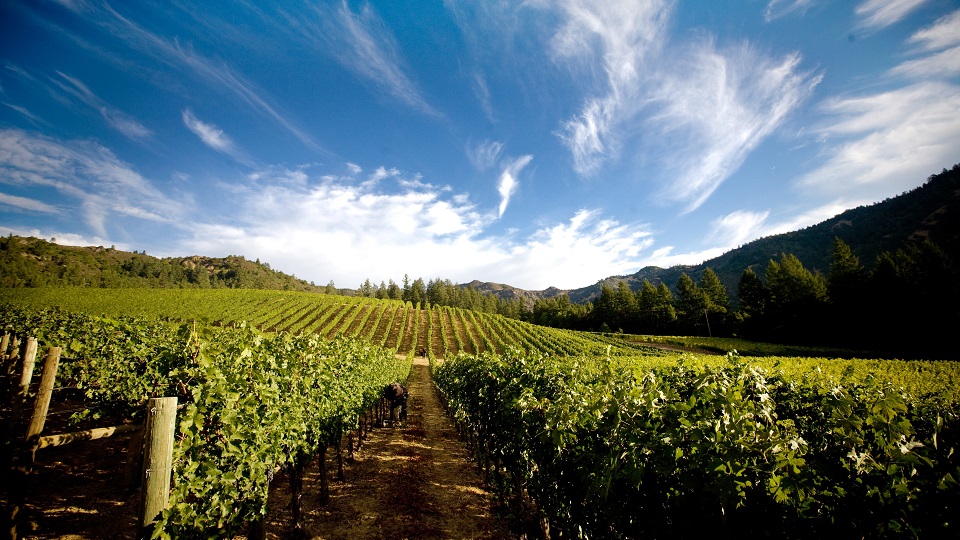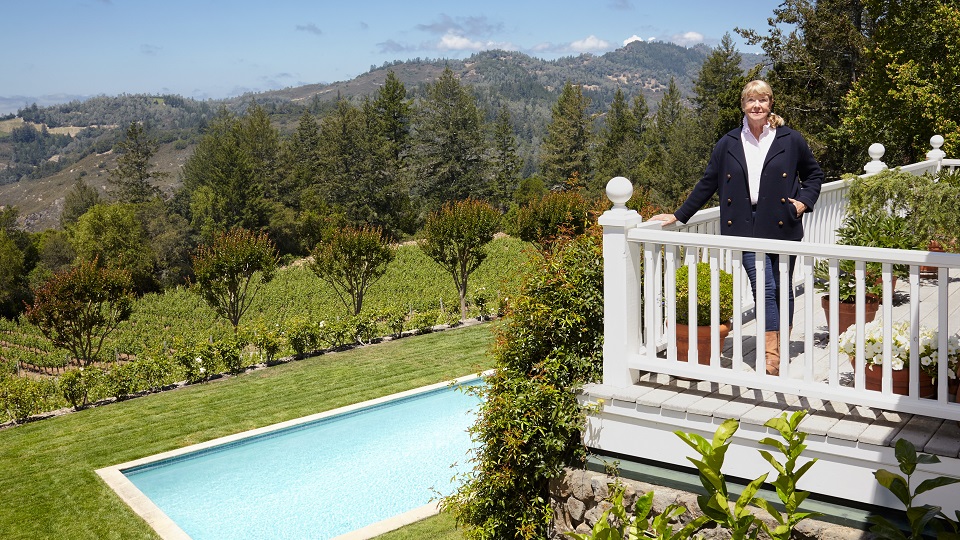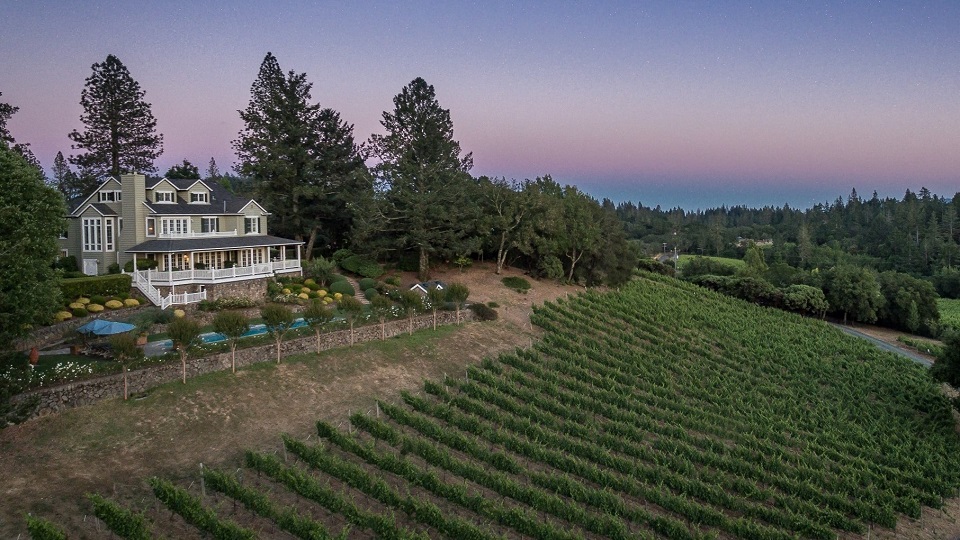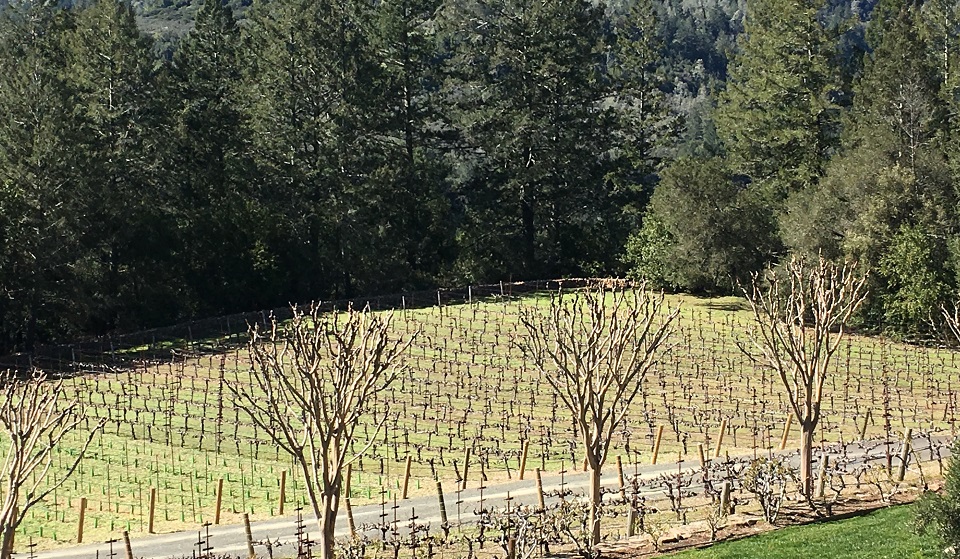Browse using the new Vinous website now. Launch →
Printed by, and for the sole use of . All rights reserved © 2015 Vinous Media
Lail Vineyards J. Daniel Cuvée: 1997-2016
BY STEPHEN TANZER | MAY 2, 2019
For a winery established less than 25 years ago, Lail Vineyards has a remarkably long back story. When Robin Daniel Lail launched Lail Vineyards in 1995, her flagship J. Daniel Cuvée was an homage to her father John Daniel, Jr. a visionary who helped to put Napa Valley on the world wine map. But her family’s Napa Valley roots were planted much longer ago.

Heimark Vineyard, a key component in the J. Daniel Cuvée
A Family Birthright Dating Back to the 19th Century
Robin Daniel Lail’s great-granduncle Gustave Niebaum, a Finnish sea captain who originally visited Alaska in the 1850s at the age of 16 and later became a wealthy fur trader in California, founded Inglenook Vineyards with the purchase of 450 acres of land in 1879. One of Napa Valley’s’ great pioneering wineries, Inglenook was making some of the best wines produced in this country by the early 1890s. Niebaum’s wife Susan (née Shingleberger) essentially raised John Daniel Jr. and his sister at Inglenook following the death of John’s mother Leah (Susan’s niece) in 1914. Gustave Niebaum had died in 1908, after which the winery was closed for three years, then reopened with Robin Daniel Lail’s grandfather John Daniel Sr. nominally in charge until the winery was shut down again during Prohibition.
When Prohibition was repealed in 1933, John Daniel Sr. directed his son—at the age of 26—to return to Inglenook and reopen the winery, which by that point was owned by Susan Niebaum. As a condition for raising his children, Susan had specified that all of her vineyard holdings would be left to John Jr. and his sister Suzanne. So when Susan died in 1936, John Jr. became co-owner with his sister and managing director of Inglenook. John Jr. rapidly became intimately involved in the family business and, with the mentorship of general manager/winemaker Carl Bundschu, and then winemaker George Deuer, Inglenook became one of the top makers of Cabernet Sauvignon in Napa Valley. Its series of “Cask Cabernets” made from the mid-’30s through 1964 is arguably the greatest string of wines ever made in California. These wines remain collectors’ items today.
John Daniel Jr. was one of the true visionaries and innovators of the California wine industry. He was one of the pioneers of varietal labeling (as opposed to generic labels like “Claret” and “Mountain Burgundy”) and Inglenook was the first estate owner to use Napa Valley as an appellation on his labels. He was also a pioneer in vintage-dating bottles. Daniel was one of the founders of the Napa Valley Vintners Association in 1944 and a tireless promoter of Napa Valley’s uniqueness as a wine region. He was a mentor to numerous people who would go on to become important figures in California wine, such as Robert Mondavi after he graduated from Stanford University in 1937 (Daniel was also a Stanford graduate). Not surprisingly, Daniel was among the first inductees into the Vintners Hall of Fame in 2008. He subsequently expanded his land holdings by purchasing the Napanook Vineyard in Yountville in 1943, with the grapes immediately going into his top Inglenook bottlings.

Robin Lail, above her Mole Hill Vineyard
A Childhood in the Vines Followed by Years in the Wilderness
John Lail Jr’s daughter Robin essentially grew up at Inglenook during the late ‘40s and ‘50s, living in the original Victorian mansion on the property and exploring the stone winery and the vast vineyard holdings (at its largest, Inglenook owned nearly 2,000 acres of land). It was during this period that she absorbed her father’s zeal for the land and the winery—and for her family legacy. But as Robin and her sister had been raised by their mother in the Mormon church, they had been discouraged from having anything to do with wine.
As Inglenook’s winemaker Deuer grew older, he and Daniel decided it was time they trained an apprentice. But Inglenook went through a frustrating period in the late ‘50s and early ‘60s during which no fewer than four of their potential recruits were quickly hired away by other wineries. And so, with no obvious heirs to take over Inglenook, and without the financial wherewithal to make major needed renovations in the winery and vineyards, Daniel sold his property in 1964 to a cooperative called United Vintners, which in turn sold it to Heublein in 1968, the year before Heublein also acquired Beaulieu Vineyard. Heublein essentially ran the Inglenook winery as an absentee landlord, focusing on the bottom line and exploiting the Inglenook name to sell a line of inexpensive, blended wines (essentially jug wines), made largely from purchased fruit. But in the 1980s, president Dennis Fife and winemaker John Richburg revived the fortunes of Inglenook, introducing a wine called Reunion that was made from Gustave Niebaum’s original vineyards, including Napanook.
Following her father’s death in 1970, Robin Daniel Lail, who had graduated from Stanford in 1962 and married Jon Lail in 1966, started taking care of her family’s remaining vineyards and in 1977 she began working as Robert Mondavi’s personal assistant. Under his guidance, she launched the first Auction Napa Valley in 1981. After five years at Mondavi, she and her sister Marky co-founded Dominus Estate in 1982 with Christian Moueix, who began farming the 124-acre Napanook vineyard on the western side of Yountville that year, and in 1983 she teamed up with Bill Harlan to establish Merryvale Vineyards, where she served as president for 12 years.
Meanwhile, changes had been made at Inglenook. In 1975, flush with profits from "The Godfather", Francis Ford Coppola had purchased Niebaum’s Victorian home, along with 1,560 acres of land that stretched to the top of Mt. St. John behind the winery. Then, in 1995, Coppola reunited the two original Inglenook parcels by purchasing the grand Inglenook chateau (finished in 1887) and 94.5 acres of surrounding vineyards. The combined operation was named Rubicon Estate in 2006, then renamed Inglenook in 2011 after Coppola purchased the Inglenook trademark.

Lail Vineyards' Mole Hill Estate on Howell Mountain
The Re-Envisioning of a Family Legacy
In the mid-nineties, Robin Lail sold out of her partnerships with Dominus and Merryvale, prompted by a vision of bringing her family’s wine legacy into the 21st century. With the encouragement of her husband, whose Lail Design Group specializes in constructing energy-efficient wineries (such as Laird Family Estate, Rudd Estate, Vineyard 29 and many others), and with the involvement of her daughters Erin and Shannon, she established her own venture, launching Lail Vineyards in 1995. Lail quickly hired Philippe Melka, whose first job in Napa Valley had been at Dominus Estate in 1991, as winemaker/enologist. Lail and Seavey Vineyard were Melka’s first consulting clients in Napa Valley and to this day Melka remains responsible for the Lail wines.
Unlike nearly all of the vertical tastings I have conducted in California and Burgundy in recent years, my tasting of the J. Daniel Cuvée, Lail’s first wine and her flagship bottling, was not a classic study of terroir, as this bottling, which began as a Bordeaux blend, has always been a blend of disparate sites and soils. At the outset (1995 and 1996), the wine included a good dollop of Merlot from a 1988 planting in a 2.66-acre parcel of Napanook that was located just across Highway 29 from Dominus and had remained in Lail’s family. (This land was the only asset Lail had received from the sale of Inglenook.) Its Cabernet Sauvignon was sourced from Vine Hill Ranch, an outstanding property in the southwestern corner of Oakville that has supplied grapes to a number of Napa Valley’s elite producers and launched their own wine in 2008. The 1995 J. Daniel Cuvée featured a high 54% Merlot and the 1996 73%. But Lail and Melka decided essentially to drop the Merlot from the blend after 2000 and in 2006 they T-budded these vines over to Sauvignon Blanc.
Lail had launched her singular Graves-style dry white wine called Georgia in 2002 but the strong early reviews for this wine resulted in the owner of the vineyard quickly taking back the fruit. So the Sauvignon Blanc from the old piece of Napanook, which was simply called Lail Vineyard at the outset but was later renamed Totem Vineyard, began to be used for the Georgia bottling. By 2008 it was the sole source for this wine, which quickly became one of California’s most consistently spectacular and multidimensional example of its style. Meanwhile, the Cabernet Sauvignon that remained in Totem Vineyard was used along with purchased fruit to launch a new Cabernet meant for earlier drinking called Blueprint.
In 1997, Robin and Jon Lail purchased a 20-acre property on Howell Mountain at an altitude of nearly 1,700 feet that included three steep acres of west-facing Cabernet Sauvignon vines that had been planted in 1993 and 1994, and this fruit immediately began to go into the J. Daniel blend. In some vintages through 2007, Lail added small quantities of fruit from vineyards in St. Helena and Coombsville, but this became unnecessary when the Heimark property at the top of Dutch Henry Canyon Road, about equidistant as the crow flies between Angwin and Calistoga, came on line. The Lails purchase this fruit under a year-to-year contract. Since 2008, Heimark has provided the third key component of the J. Daniel Cuvée, along with the Mole Hill and Vine Hill Ranch sites. Lail noted that Heimark produces “fruit that acts much like Howell Mountain grapes, but maybe with even more tannins.” The vineyard is situated at 1,200 feet, on what winemaker Melka describes as “very warm, well-trained tufa soil, almost gravelly.” In contrast, Mole Hill features reddish loamy soil (technically, Aiken series clay-loam) with a lot of small rocks, with barely two feet of topsoil at its deepest, according to Lail.
As Heimark typically ripens at a higher level of potential alcohol than do Lail’s other sources, the J. Daniel Cuvée, which through 2002 had not exceeded the low 14s, jumped to 16.4% alcohol with the 2006 vintage. Since that year, the wine has been mostly between 15% and the low 16s, although Lail assured me that the wine “has been swinging a bit back toward elegance, and away from opulence, since the recent string of drought years. But we’re still picking for flavor,” she added. And Heimark is hardly acid-deficient: Lail described her fruit from Mole Hill as having “guitar-string acidity—and Heimark even more so, typically with boysenberry and spice elements.” Melka describes Heimark as “like the Pauillac of Napa Valley, with a lot of sophisticated tannins,” while the tannins of Howell Mountain fruit tend to be more rustic. (But Melka also noted that the Mole Hill site “is not extremely tannic.”)
Lail’s Napa Valley adventure has thus veered radically from her original family birthright on the valley floor. Today’s J. Daniel Cuvée is roughly two-thirds mountain fruit, whereas the first two vintages, 1995 and 1996 were entirely from vineyards in Yountville and Oakville.

A view of Mole Hill Vineyard
A Flexible, Talented Winemaker
Philippe Melka, who has become one of the most popular consulting winemakers in Napa Valley over the years—and now has projects in Sonoma, Santa Barbara, Washington and Chile as well—is known for making wines with minimal intervention. He has also established a reputation for allowing each of his clients’ wines to express their own inherent personalities rather than trying to force them to conform to any particular model. He’s not a partisan of freakishly low production; rather he seeks a balance between fruit yields and canopy strength. He often tries to “homogenize” ripeness through selective green-harvesting, and will also eliminate collapsing grape clusters following dehydrating heat waves.
Melka told me he never acidifies the J. Daniel Cuvée because (1) he’s French, (2) he began his career in wine in Bordeaux, and (3) he believes that Cabernet Sauvignon already has sufficient structure from its tannins. (Lail seconded this approach by noting that “acidification always creates an elbow in the wine.”) Over the years, the finished pHs have consistently ranged between 3.7 and 3.93.
Melka normally starts with cool grapes that warm up slowly in stainless steel tanks before starting to ferment (with a combination of indigenous and commercial yeasts). He will chill the tanks in warmer vintages in order to reserve freshness but generally eschews temperature manipulation. Extraction is slow, with the maximum fermentation temperature rarely exceeding 30 degrees C. He does two or three pumpovers per day during the peak period of the fermentation as well as délestage (rack and return), and occasionally makes use of punchdowns. Total time on the skins in tank is normally about 35 days, including 4 to 5 days of pre-fermentation cold soak and 7 to 10 of post-fermentation maceration. Since 2001, the Lail wines have been made at the Arkenstone Vineyards winery, barely half a mile from Mole Hill.
From the start, the J. Daniel Cuvée has spent about 20 months in barrel, but the percentage of new oak has risen from about 50% originally to 75% to 80% nowadays. Melka has always blended barrels from multiple coopers, of which the most important through the years have been Taransaud, Demptos and Sylvain. From the start, the malolactic fermentation has taken place in the barrels.
Annual production of the J. Daniel Cuvée was in the range of 1,200 to 1,500 cases through the 2000 vintage but has been mostly between 500 and 900 cases since then, as Lail Vineyards began to produce additional bottlings. Total estate production is now around 4,000 cases, which in some years has included a very limited bottling made entirely from Mole Hill, a wine that Lail described as “aromatically complex, dense and velvety and extremely representative of Howell Mountain but not as powerful as the J. Daniel blend.”

A line-up of the Lail Vineyards J. Daniel Cuvée
A Few Notes on the Vertical Tasting
I should point out that I was not an early advocate of the J. Daniel Cuvée, even though some other critics were giving the first releases rave reviews. In some vintages prior to 2001, I found the wines a bit inky, medicinal or forbidding in the early going, sometime owing to drying tannins. In retrospect, that may have been due to the major presence of Merlot. (At the vertical tasting in March, I did not taste the Merlot-dominated ’95 or ’96.) Fortunately, beginning with the 2001 vintage the Merlot essentially disappeared from the blend. Melka tactfully noted that he and Lail determined that to get the style of wine they wanted, the wine had to be at least 75% Cabernet Sauvignon. And he asserted that “2001 marked the beginning of global warming in California,” and that in 2001 and the following two growing seasons, serious heat waves in September resulted in a lot of shriveling of the fruit. “That’s one reason Merlot started disappearing,” said Melka. “It did not perform well under those conditions.”
So the wine quickly went to 100% varietal, with only a couple of vintages since then including tiny percentages of Merlot or Petit Verdot. (Still, the wine was not labeled Cabernet Sauvignon until the 2003 bottling.) Not coincidentally, Merlot was being phased out of the Dominus Estate blend in the late ‘90s, disappearing entirely after the 2002 harvest.
The J. Daniel Cuvée has been consistently excellent since 2001, and I can say “consistently” because Lail bravely presented every vintage back to 1997. Although there were numerous highlights from the first decade of the new century, what impressed me most was the string of exceptional wines that were made during the North Coast’s extended period of drought from 2012 through 2016. Neither Lail nor Melka had an easy explanation, and it’s hard to avoid falling back on the axiom that sites acquire a reputation for quality over time through their ability to produce balanced grapes under a range of weather conditions year in and year out. Melka specifically mentioned the 2015 vintage, which he described as his earliest Napa Valley harvest ever, along with the 2004. “We picked virtually a month earlier than usual and the berries were tiny,” he recalled. “We expected monster wines, but they somehow kept their freshness. And there were no seeds in the berries that year, so the tannins were softer at the end.”
My own feeling is that wines made from disparate components frequently need more time to harmonize in bottle than those from a single site. And perhaps the Merlot in the earliest vintages was particularly awkward. Even some recent vintages of the J. Daniel Cuvée have been tough in the early going, but this is a wine made for extended aging. As the three key components of the wine have been steady in recent years, with the vines gaining in maturity, the best is yet to come.
See the Wines from Youngest to Oldest
You Might Also Enjoy
Beaulieu’s Georges de Latour Private Reserve: 1965–2016, Stephen Tanzer, April 2019
Dunn Cabernet Sauvignon Howell Mountain Vertical: 1979 – 2014, Stephen Tanzer, August 2018
Vintage Retrospective: 1991 Napa Valley Cabernet Sauvignon, Stephen Tanzer, July 2018
Williams Selyem: Pinot Noir Allen Vineyard 1987–2016, Stephen Tanzer, June 2018
Turley Zinfandel Hayne Vineyard: 1993 – 2015, Stephen Tanzer, May 2018
